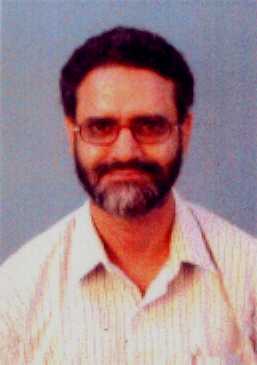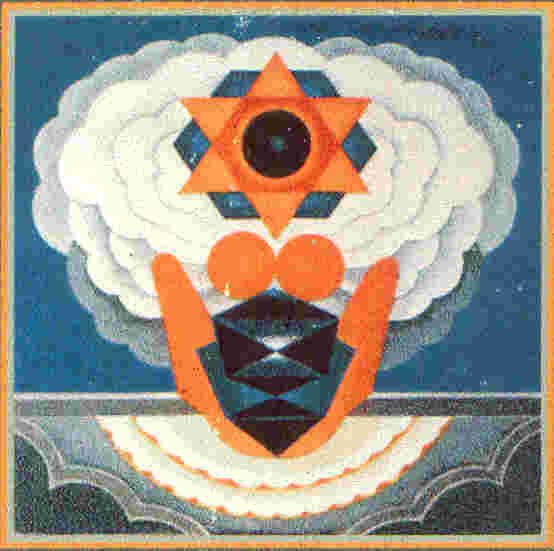|
Milchar
March-April 2004 issue
|

|
Kashmir's
Students
of the Vinod Sur Shringar Music Academy
performing
at the Annual Cultural Nite at Rang Sharda, Bandra
|
|
 |
|
Our Heritage
Aspects of Kashmiri Pandit Culture - 3
... Raj Nath Bhat (BHU)
Click: Part
1 | Part 2
 Death rites : Death rites :
When a person breathes his / her last, his/her mortal remains are washed in water to which Ganga jal is added. Cotton buds are put into his / her ears and nostrils. A coin is placed at its lips. The whole body is covered in a white shroud and tied with a thread
(närívan). The body is then placed on a plank of wood and four persons take the coffin on their shoulders to the cremation ground. The eldest son of the deceased carries an earthen pitcher in his hand and leads the coffin. Some distance away from the cremation ground, the coffin is placed on the ground and the family members, relatives and friends are allowed to have a last glimpse of the deceased’s face. The coffin is then taken to the cremation ground and put on a pyre. The eldest son, after taking three rounds around the pyre, lights it. From second to the ninth day of one’s death, his/her eldest son and daughter come out on to the house threshold before sunrise and call upon their departed father/mother a couple of times, asking him:
bôchhí mà låjíy babò / mäjì?
(Are you hungry father/mother?)
trèsh mà låjíy babò / mäjì?
(Are you thirsty father/mother?)
tür mà låjíy babò / mäjì?
(Are you feeling cold father/mother?)
On the fourth day of cremation the sons and some relatives and family friends go to the cremation ground to gather ashes
(åstrûk). Most of it are immersed into a nearby river /stream and a part is put into an earthen pitcher and taken to Haridwar for immersion into the holy Ganges.
On the 10th day, the sons of the deceased along with many relatives and the family purohit go to a river bank where sons’ heads are shaved and a Shraadha is performed. The relatives after having lunch leave the family of the deceased alone. On the 11th day, the sons and daughters perform a very elaborate Shraadha under the guidance of a
purohit. The ceremony ends with aahuuti given to agni invoking almost all the deities, major rivers, temple towns, mountains, and lakes of South Asia. On this day the daughters too pay dakshina to the purohit and arrange food for the families of their brothers.
On the same day, ‘oil’ is provided for the deceased (tìl dyún) in which mustard oil is poured into a large number of earthen lamps and cotton wicks are immersed and lighted in them. Favourite vegetarian foods are prepared in the name of the deceased. Burning of oil lamps is meant to provide light to the deceased in the ‘other’ world.
Another Shraadha is held on the 12th day after death. This marks the end of the mourning, when married daughters return to their homes.
During the first three months, a Shraadha is performed after every fifteen days i.e. on the 30th, 45th, 60th, 75th and 90th day of death . An elaborate Sharaadha is held on the 180th day
(shadmòs). The Shraadha on the first death anniversary (våhårûvär) too is an elaborate one. Daughters and sons and their husbands/wives assemble to perform both shadmòs and
våhårûvär.
After this a Shraadha is done every year on the death anniversary and one during the
pitra-paksh. The children (sons and daughters) offer water to their deceased parents and three generations of grandparents every morning.
Language and food :
KP has been a polyglot throughout the known history. Besides mother tongue (Kashmiri) it has had a sound knowledge of Sanskrit, Persian, Urdu-Hindi, and English at different periods in history. Literatures of these languages are a testimony to their genius and creativity. Their original contributions in the areas of philosophy, theology, aesthetics, logic, grammar, astronomy etc. occupy a place of pride in the extant literatures of these disciplines.
KP loves vegetarian foods yet mutton and fish have been its favourite. Rice and knolkhol (hàkh batû) has been its primary requirement. The use of a wide variety of spices, e.g. aniseed powder, turmeric powder, chilly powder, ginger powder, black-pepper, cardamom, saffron etc. is very common among the KPs. Besides knolkhol, KP relishes beans, potato, spinach, lotus-stalk, sonchal, raddish, turnip, cabbage, cauliflower, wild mushroom, cheese and an assortment of local greens like lìsû, vôpal hàkh, núnar, vôstû hàkh and hand. The major mutton preparations of the KP include: kålíyû, ròganjòsh, matsh, kabar gàh, yakhûni, rístû, tabakh nàt, tsók tsarvan etc.
To Conclude :
After the advent of Islam in the Valley, when Persian replaced Sanskrit as the language of administration, senior members of the Pandits (a large majority had been forced to embrace Islam) organized a kind of a conference to deliberate on and find means to preserve their religion and culture so as to prevent it from becoming extinct. In that historic conclave, it was decided that in order to participate in State administration, it were necessary to learn Persian, so the son’s son would learn the language of administration and the daughter’s son, if he were educated by his maternal grandparents, would learn bhasha ‘Sanskrit’ and religious scriptures and eventually perform religious rites and rituals. Thus, two distinct sects, one of bhasha Pandits or purohits ‘clergymen’ and another of the karkun ‘the men of administration’ were created. In course of time the Purohit became dependent upon the Karkun for dakhshinaa ‘offerings’ to make his living and the Karkun came to be considered a superior class to the men of religion. This historic ‘decision’ has brought the community to an impasse now where the purohits too have diminished in number and the very identity of the community is at stake. At this juncture, it is not only the religious rites and rituals, customs, festivals and ceremonies, beliefs, myths and superstitions that are under threat of extinction, but also their mother tongue, which was not under threat during the Muslim period.
The community elders need to sit together again to think about its linguistic and cultural heritage and evolve a strategy to preserve it. Otherwise, the literary and religious writings of
Laleshwari, Parmanand, Zinda Koul will have no takers in near future.
| |
 |
|





 Death rites :
Death rites : 

